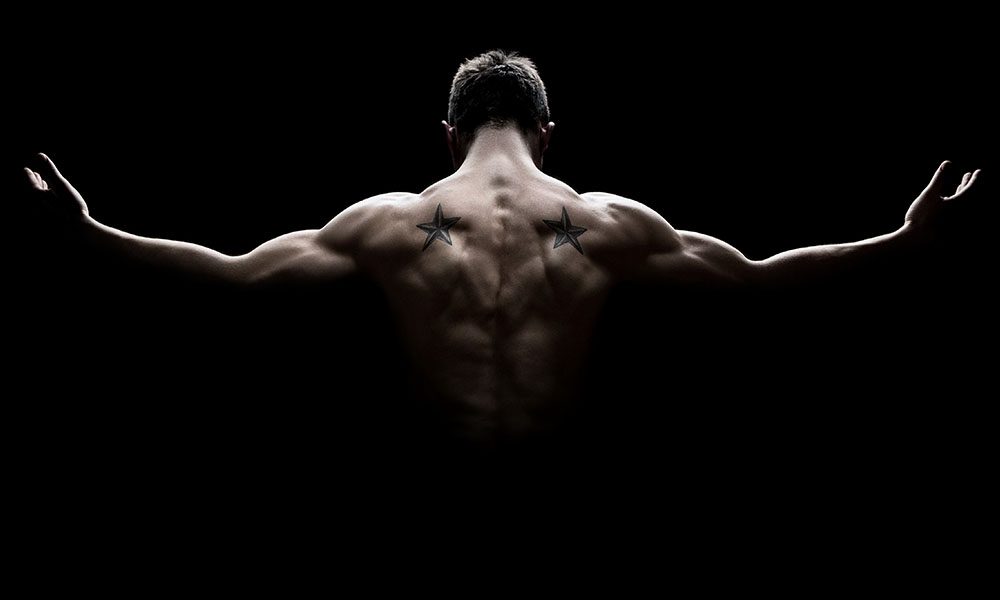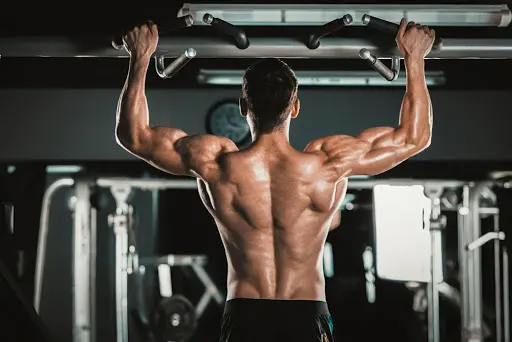
The best online fitness resource you'll ever need. We filter out the BS to ensure you meet your health and fitness goals!

The best online fitness resource you'll ever need. We filter out the BS to ensure you meet your health and fitness goals!

Whether you train for performance, health, aesthetics, or a mixture of all three, strong, wide shoulders are something of a must. For those looking at aesthetics, the ratio between shoulders and waistlines- especially for men- is often seen as a crucial factor. For those looking to generate and maintain power through the torso and to keep their bodies in top condition with any degree of longevity, strong delts, traps and upper back and chest muscles need to be built up and maintained in good condition.
But how can you build boulder shoulders that look and work how you want them to? And how can you do so with minimal equipment, using simple, calisthenic bodyweight exercises?
Let’s get into it. In this article, we will look at what it means to have built up shoulders, what the benefits are, and why you might want to give them some attention. Then we will look into some of the top calisthenic exercises for eliciting strength gains and hypertrophy through the shoulders, before rounding it off with a sample workout guaranteed to make you feel the burn.
Having broad, strong shoulders can do wonders for you in a variety of ways, across a variety of disciplines.
Aesthetics are a given: if you train in bodybuilding or are just looking to buff up, train your shoulders. They will give you the v-taper that so many people want and will make you look amazing in suits and shirts.
For powerlifters, who typically don’t compete in overhead press variations, shoulders should still form a staple part of your training. They will add a great deal of power to your chest and upper back, meaning more strength through the bench and deadlift. For other strength athletes, like Olympic lifters and Strong Man competitors, shoulder strength is vital- overhead loading is key and you should be training them by virtue of your existing training regime. If not- or if your overhead lockout or stability are lagging- it will be a good idea to give your shoulders some extra attention. The exercises and workout below will be a very good starting point.
If you’re into bodyweight training- calisthenics chiefly, but also disciplines like yoga and Pilates- shoulders are often left behind. It’s easy to train the chest, anterior deltoids (more on these below) and triceps. Working shoulders and back is often trickier; many routines neglect them. Consider taking some of the exercises below and incorporating them into your routine. Consider devoting entire sessions to them, as detailed below.
Finally, there is a lot to be said for functional training (though I don’t quite mean one-legged stands on bosu balls here…) For a lift to be worthwhile, it has to have practical, real-life carryover. All of the movements below tick this box. Strengthening your shoulders will help you with everyday loading- carrying the shopping, playing with the kids, lifting furniture about, and so on. Doing so using your bodyweight brings its own advantages, as any calisthenics devotee will tell you.

So, what are we talking about when we talk about the shoulders? Primarily, the three caps that overlap and form the boulder part of the boulder shoulder come into play: these are the deltoids (delts). Aside from this, we will be looking at rotator cuffs and, to a lesser extent, the trapezius muscles (which we cover in greater detail here [MICHAEL- link here to back training article on TIYIF]).
The exercises below will hit all of these in greater or lesser degrees. However, the anterior and medial heads will get the greatest benefit from most shoulder days- it’s often advisable to work the posterior delts during a devoted back session, as they are key in retraction and any kind of rowing work.
These are the ones at the front. They sit atop your upper arm, leading to the shoulder joint itself. Any exercises that move your arms out in front will work them- think chest presses and push ups. Dips are a great way to hit them, though we’ve left them out of our list below as this is more of a chest builder with the anterior deltoids as an accessory movement.
This is in the middle, out to the side of the anterior deltoid. Any exercises that involve you moving your arms away from you, either out to your sides or above your head, will engage the medial head. Overhead press variations get into them nicely, as do hand stand exercises (see below).
This is the back of your deltoids and, as mentioned above, deals with shoulder retraction. Rows and flys work them best, meaning that they really come into play during back training- again, mentioned above.
The deltoids sit on the outside and are responsible for large scale movements. They see the greatest hypertrophy gains. The rotator cuff is arguably far more important, however, especially in the long run. It is formed of four small muscles, all clustered tightly around the joint. Alongside aiding movement, they are also key for deep stability. Interspersing dynamic work with isometric holds will aid them greatly.

It’s common to think of a few things when we talk of large muscle groups: the legs, specifically the quads and glutes; the back, both lower and upper; the chest. The shoulders sometimes get left out of the conversation.
However, as we’ve already seen, you shouldn’t underestimate their importance, either for performance of aesthetics. They are involved in a large way in every movement you perform with your upper body and are great stabilisers for many lower body exercises, as you hold onto resistance and manipulate it to perform.
Neglecting the shoulders can also lead to injury over time, as those vital rotator cuffs lack the strength to bear the burdens of both everyday life and, crucially, of hard exercise. Performing dips and pull ups with weak rotator cuffs is almost certain to lead to tearing, long-term pain and debility, and short-term loss of performance.
Though they are a large muscle group, shoulders are made up of smaller individual muscles. The deltoids are tiny compared to the lats, quads and pecs, for example. This means that they should be trained slightly differently. As a rough (very rough) rule of thumb, there is an inverse relationship between the size of a muscle and how often it should be trained: the smaller the muscle, the more you want to work it; the larger, the less.
Shoulders also don’t mean much stimulation to grow, unlike the larger muscles mentioned above. A small amount, little and often, will bring about the right level of fatigue and overload required, and will take advantage of the fact that they can repair and be good to go again within a couple of days.
This means that shoulders should be trained under moderate to light loads, fairly often. High reps, plenty of volume, several times per week.
This doesn’t mean that you should devote a full training session to them this often. In fact, if you’re hitting your upper body hard with compound movements like dips, chin-ups and so on, you won’t need to do too much more: your shoulders are involved in each of these, meaning they get enough stimulation to grow.
Try aiming to train your shoulders twice per week. Train them alongside other upper body compounds. After you’ve completed a few different exercises for the main body part (chest, back, and so on), finish with a couple of exercises for your shoulders. This isn’t neglecting them, like I cautioned against above- this is an incredibly effective way to make sure that they aren’t neglected, and they can keep up with the rest of your upper body.
If this isn’t enough for your shoulders, or if you want to give them some extra attention, add a third day in. Keep it relatively light, just train your shoulders alone, following a similar protocol to the one described below, and make sure there is at least 24 hours either side in which you don’t train your upper body.
This brings us onto the main event: how do you hit the shoulders during a bodyweight, calisthenic workout? What are the best exercises for making sure that all components of the shoulder- each deltoid, alongside the rotator cuff muscles- are trained adequately?
Include these five exercises in your routines and there will be little else you need to do to make sure you have broad, strong, stable shoulders.
This is where everybody looking to build their shoulders using calisthenics should begin. Pike push ups are intuitive, easy enough to perform, yet still bring enough stimulus to elicit hypertrophy and strength gains. They target the anterior and medial deltoids, as well as the triceps, all as active movers.
To perform pike push ups:
This is another push up variation that puts more pressure into the shoulders- specifically the anterior deltoids- than more standard push up styles. You will begin with your feet elevated on a box, bench or step, then perform push ups, feeling your anterior delts begin to work.
To perform decline push ups:
If you feel any kind of joint pain whilst performing decline push ups- specifically in your wrists- try scaling it back and replacing them with pike push ups.
This is another beginner move, though athletes of all levels can benefit from including YTWLs in their regular training. They are great for maintaining deep shoulder mobility, for working the rotator cuff muscles through deep ranges of motion, and for warming up the deltoids for harder, more intense exercises later on.
To perform YTWLs:
Handstands are perhaps the ultimate test of shoulder strength and stability. They you’re your muscles isometrically- especially the deep rotator cuff muscles- in a bid to keep you stable and aligned to the correct centre of gravity, and the time under tension you get with them will lead to a great deal of muscle growth despite there being little range of motion involved in the exercise.
To perform a handstand:
This is simple to explain yet incredibly hard to execute and maintain. As you begin, try performing wall hand stands, with your back to the wall when you’re in position for added stability and a bit of a safety net.
To add a bit of motion to this movement, and to prepare yourself for standing in a full handstand, try wall walks. These hit all the deltoid heads whilst really working into rotator cuff stability.
To perform wall walks:
This is the ultimate combination of all of the above, testing and training stability whilst taking your anterior and medial deltoids through a wide range of motion, under high load.
To perform handstand/wall push ups:
Obviously, this is an advanced, quite dangerous exercise. Don’t attempt it if your handstand isn’t stable, or if you have any issues with your wrists, elbows or shoulders. And, also hopefully obviously, try not to fall and land on your face.
This is a full sequence designed to zero in on the shoulders. As mentioned above, you may want to add shoulders into your chest and back days. In this case, simply pick a couple of pieces from this routine to include, then simply mix and match.
For this workout: